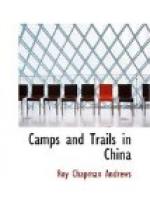Repassing the Lolo village, we followed the river gorge at the upper end of which Chung-tien is located and left the forests when we emerged on the main road. From the top of a ten thousand foot pass there was a magnificent view down the canon to the snow-capped mountains, which were beautiful beyond description in their changing colors of purple and gold.
Just after leaving the pass we met a caravan of several hundred horses each bearing two whole pigs bent double and tied to the saddles. The animals had been denuded of hair, salted, and sewn up, and soon would be distributed among the villages somewhere in the interior of Tibet.
On the second day we saw before us seven snow-crowned peaks as sharp and regular as the teeth of a saw rising above the mouth of the stream where it spreads like a fan over a sandy delta and empties into the Yangtze. Here the mighty river, flowing proudly southward from its home in the wind-blown steppes of the “Forbidden Land,” countless ages ago found the great Snow Mountain range barring its path. Thrust aside, it doubled back upon itself along the barrier’s base, still restlessly seeking a passage through the wall of rock. Far to the north it bit hungrily into the mountain’s side again, broke through, and swung south gathering strength and volume from hundreds of tributaries as it rushed onward to the sea.
For two days we rode along the river bank and crossed at the Shih-ku ferry. There was none of the difficulty here which we had experienced at Taku, for the river is wide and the current slow. It required only two hours to transport our entire caravan while at the other ferry we had waited a day and a half. Strangely enough, although there are dozens of villages along the Yangtze and the valley is highly cultivated, we saw no sign of fishing. Moreover, we passed but three boats and five or six rafts and it was evident that this great waterway, which for fifteen hundred miles from its mouth influences the trade of China so profoundly, is here used but little by the natives.
On the ride down the river we had good sport with the huge cranes (probably Grus nigricollis) which, in small flocks, were feeding along the river fields. The birds stood about five feet high and we could see their great black and white bodies and black necks farther than a man was visible. It was fairly easy to stalk them to within a hundred yards, but even at that distance they offered a rather small target, for they were so largely wings, neck, legs, and tail. We were never within shotgun range and indeed it would be difficult to kill the birds with anything smaller than BB or buckshot unless they were very near.




